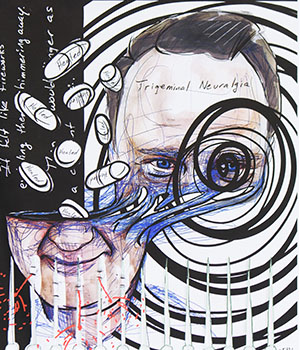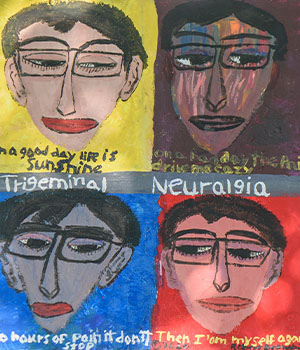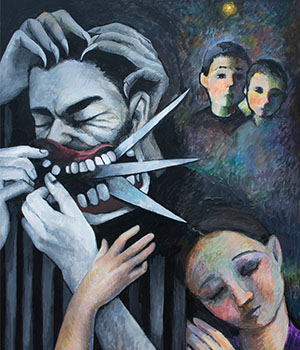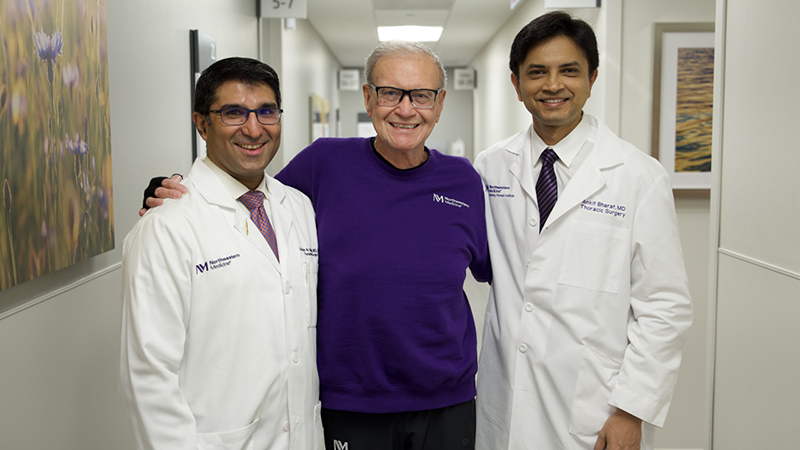Portraits of Pain
Published September 2020
Living With Trigeminal Neuralgia
The American Association of Neurological Surgeons describes it as “the most excruciating pain known to humanity.” What exactly is trigeminal neuralgia, and why is it so debilitating?
Trigeminal neuralgia is a type of chronic nerve pain that comes from the trigeminal nerve, which is the largest and most complex of your cranial nerves. It is located at the base of your brain and carries sensation from your face to your brain. Therefore, much of the pain experienced occurs along the jawline and side of the face.
Here, individuals share their stories and work with artists to reflect on what the pain feels like with this rare neurologic condition.
A Sharp Blast – Like Fireworks

Vicky Hallberg, Franklin Park, IL, mixed media
Todd first noticed his condition while washing his face, when he would occasionally experience intense pain he likens to fireworks.
Joshua M. Rosenow, MD, director of Functional Neurosurgery at Northwestern Memorial Hospital, shares, “Trigeminal neuralgia is one of the most significant and disabling challenges we face in the field.” Because Todd, who works in financing, spends much of his workday talking with others, he had to create an information sheet explaining the severity of his pain when an attack would come on because he couldn’t speak.
He originally thought he had a dental issue but couldn’t pinpoint which tooth hurt. However, he knew someone with trigeminal neuralgia, which helped him find specialized care and treatment with medication.
The medication worked for a few years until the pain intensified and basically ruined his family vacation. “I told myself I was seeing a neurologist and making a change as soon as I got back home,” says Todd. It was then that he connected with Babak S. Jahromi, MD, PhD, vice chair of neurological surgery at Northwestern Medicine.
Once trigeminal neuralgia is properly diagnosed, there are several treatment options available. “There are a number of excellent medical and surgical options which provide a multimodal approach to treatment. This is where having a collective team with multiple areas of expertise is beneficial,” says Dr. Jahromi.
Dr. Jahromi and Todd decided on a treatment known as microvascular decompression (MVD). In this procedure, the surgeon inserts a small sponge between the nerve and the compressing blood vessel. The procedure does not damage the nerve.
“I woke up and my pain was gone,” Todd says. He admitted that, overall, it took some time for him to recover. “Dr. Jahromi was very persuasive and motivating. I would get up and walk around slowly. But once I recovered, I did not have any issues.”
Todd's story of having pain near the jawline is not uncommon. Trigeminal neuralgia is often perceived as a dental issue, much like the patient in our next story.
A Thousand Needles

Bobbie Brown, Chicago, IL, acrylic paint on canvas
A thousand needles, pressing deep into the nerve — that’s how Jeffrey Krudys describes his pain. “For me, it feels like a stabbing, pulsing pain that goes into my left jaw, from my sideburn to the center of my lip. It can last anywhere from 30 seconds to up to two hours, like moving needles around in my jaw,” he says. “It’s just terrible.”
Jeffrey was diagnosed with trigeminal neuralgia in 2018 at the age of 21. He originally thought he was having issues with his wisdom teeth. Yet, after the teeth were removed, the pain persisted.
At that point, his physician introduced him to Northwestern Medicine where he has been under the care of Dr. Jahromi. He finally found temporary relief with a balloon compression rhizotomy. This procedure is conducted during an outpatient visit by placing a needle through the cheek into the trigeminal nerve. “It was like the dream surgery. I didn’t have to take any medication afterward,” Jeffrey says.
Unfortunately, the pain did return. His care team is looking at other treatment options, but for Jeffrey, who has brittle bone disease, certain treatments aren’t a viable solution. “Jeffrey’s condition is by far one of the most complex challenges because a portion of his spine is pushing on the nerve,” says Dr. Jahromi. “This is where having a multidisciplinary team and multiple treatment options pays off.” His care team is working with other specialists to understand his unique case in order to make recommendations that are both safe and effective.
Although his pain is returning and other options are being considered, Jeffrey stays positive. “I’ve been very aggressive with my options, and I am glad because it’s gotten me to where I am today,” he says.

Kerry Simmons, Fox Lake, IL, acrylic on panel
Pain That's Black or White
Abraham Magana, 39, also had to undergo several options to get to where he was today.
In a visual sense, everything about his pain from trigeminal neuralgia is black or white. “The pain is really bad, there’s just no in between,” he says. Abraham likens it to being stabbed with a knife, especially along his lower jaw. “I wanted to rip my head open to get out whatever was in there,” he admits. And for someone who is lively and enjoys talking a lot, this became problematic and had an impact on his everyday life.
At his worst, he didn’t want to be around anyone. “I felt useless and angry,” he says. “I felt like less of a man because I couldn’t really be with my children. It was pretty rough.” The pain got to the point where simple tasks, like speaking and eating, became too difficult and too painful.
His journey hasn’t always been this painful, but it certainly etches deeply on his mind. For Abraham, the pain began about three years ago.
“In the beginning, I was trying to figure out what it was. It was a process to try and figure out what it was and what I had,” says Abraham. He kept researching online and found that everything was pointing to trigeminal neuralgia. A neurologist confirmed the diagnosis, and that’s when he started the process of medication.
However, after the pain persisted, he had an MVD and continues to receive care under Dr. Jahromi. “He takes the time to listen to you and discusses the science behind what is happening,” says Abraham.
Unfortunately, the pain has returned, but it has lessened. Dr. Jahromi and Dr. Rosenow continue to focus their research to better determine which types of treatment are less likely to result in recurrence of pain. Yet, pain returning is always a possibility with trigeminal neuralgia and true to the nature of the condition.
“I thought we were done with it. But it’s nowhere near as bad as it was before,” says Abraham. Thankfully, he is no longer afraid to eat, shave or brush his teeth because of the pain it would cause. More importantly, he can go back to being a father again.
“In contrast, my family is in full color. I can enjoy the day with my kids,” adds Abraham. At his worst point, that was impossible. Despite everything, his family has been by his side, doing everything to comfort him on his journey.

Mark Zlotkowski, Chicago, IL, oil on canvas
Triggered by the Slightest Touch
With trigeminal neuralgia, it’s important to have support and understanding from family and friends.
Pat Tomasulo is known for his comedic flair. He brings laughter to many on the WGN Morning News. But there is one important issue to him that is no laughing matter. His wife Amy has trigeminal neuralgia. Together, they raise awareness and funding for The Facial Pain Research Foundation.
It was shortly before they met in 2001 that Amy was diagnosed. “I woke up with the pain and just didn’t feel right. I was having these episodes of pain,” she says. “I thought I was coming down with a sinus infection.” She describes it like a dull ache.
“I no longer have that underlying ache, but now I get episodes of pain every day. They are triggered by wind, a light touch, air from a blow dryer and brushing my teeth,” says Amy. Consequently, it makes daily tasks difficult, like walking her dog or running errands, if there is any wind.
“It’s like a jolting, shocking feeling. Almost like an ice pick or dull knife,” she says. It starts in her temple and comes through her forehead, down her jaw and into her cheek. Amy underwent an MVD, but it was not successful in providing relief. These days, she is using medicinal treatment to manage the pain as best as she can.
Together, Pat and Amy share their experience with others and host the annual Laugh Your Face Off event to continue raise money for The Facial Pain Research Foundation. To date, they have raised more than $1.7 million. They have also created a community that understands what it’s like to live with facial pain, such as the pain from trigeminal neuralgia.
“It’s a very close-knit group and we want to continue to cultivate that,” says Pat. “They know that something is being done for them and there is some hope. But we are in the early stages of this fight, and we are going to need continued support. We are always looking forward.”
“At Northwestern Medicine, we’re not just focused on the best treatments today. We want to be part of innovating, creating and leading the path for better treatments for tomorrow,” says Dr. Jahromi. “It’s a condition where, despite many treatments, there is still a substantial burden. We’re proud to partner with Pat and Amy to find a cure for this debilitating disease.”
Even though every person’s experience and story is different, it is these narratives that drive the funding, research and the quest for a better tomorrow.
“We won’t stop until we’re done,” says Pat.






